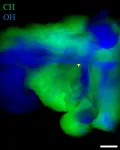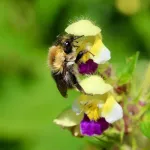(Press-News.org) Tuberculosis is a confounding scourge. It’s the leading cause of death from infectious disease in the world, and yet it’s estimated that those deaths represent perhaps 5% of infections with Mycobacterium tuberculosis (Mtb). Antibiotics can take credit for saving the lives of some of those with Mtb, but a chasm nevertheless persists between the prevalence of infection and the targeted severity of its impact. A growing body of evidence suggests genetic vulnerabilities to TB account for that gap.
Now researchers from The Rockefeller University have found another rare mutation that leaves its carriers much more likely to become ill with TB—but, curiously, not with other infectious diseases. This finding, recently published in Nature, may upend long held assumptions about the immune system.
It’s long been known that an acquired deficiency of a pro-inflammatory cytokine called TNF is linked to an increased risk of developing TB. The current study, led by Rockefeller’s Stéphanie Boisson-Dupuis and Jean-Laurent Casanova, revealed a genetic cause of TNF deficiency, as well as the underlying mechanism: a lack of TNF incapacitates a specific immune process in the lungs, leading to severe—but surprisingly targeted—illness.
The findings suggest that TNF, long considered a key galvanizer of the immune response, might actually play a much narrower role—a discovery with far-reaching clinical implications.
“The past 40 years of scientific literature have attributed a wide variety of pro-inflammatory functions to TNF,” says Casanova, head of the St. Giles Laboratory of Human Genetics of Infectious Diseases. “But beyond protecting the lungs against TB, it may have a limited role in inflammation and immunity.”
Rare risk
Casanova’s lab has been studying the genetic causes of TB for more than two decades through field work in several countries and a wide network of collaborating physicians across the world. They maintain an ever-growing database of whole-exome sequences from a global pool of patients—more than 25,000 people to date. Of those, some 2,000 have had TB.
Over the years they’ve identified several rare genetic mutations that render some people vulnerable to TB. For example, mutations in a gene called CYBB can disable an immune mechanism called the respiratory burst, which produces chemicals called reactive oxygen species (ROS). Despite its pulmonary-sounding name, the respiratory burst takes place in immune cells throughout the body.
ROS help pathogen-consuming white blood cells called phagocytes (from the Greek for “eating”) to destroy the invaders they’ve devoured. If ROS aren’t produced, those pathogens can thrive unchecked, leading to debilitating complications. As a result, carriers of this CYBB mutation become vulnerable to not just TB but to a wide variety of infectious diseases.
For the current study, the team suspected that a similar inborn error of immunity may lay behind the severe, recurring TB infections experienced by two people in Colombia—a 28-year-old woman and her 32-year-old cousin—who had been repeatedly hospitalized with significant lung conditions. In each cycle, they initially responded well to anti-TB antibiotics, but within a year, they were sick again.
Puzzlingly, however, their long-term health records showed that their immune systems functioned normally, and that they were otherwise healthy.
A telling deficiency
To find out why they were particularly prone to getting TB, the researchers performed whole-exome sequencing on the two, as well as a genetic analysis of their respective parents and relatives.
The two were the only members of their extended family with a mutation in the TNF gene, which encodes for proteins linked to the regulation of a variety of biological processes. Short for “tumor necrosis factor,” increased TNF production is also associated with a variety of conditions, including septic shock, cancer, rheumatoid arthritis, and cachexia, which causes dangerous weight loss.
The protein is largely secreted by a type of phagocyte called a macrophage, which relies on the ROS molecules generated by the respiratory burst to finish off pathogens they’ve consumed.
In these two patients, the TNF gene failed to function, preventing the respiratory burst from occurring, and thus the creation of ROS molecules. As a result, the patients’ alveolar macrophages, located in their lungs, were overrun with Mtb.
“We knew that the respiratory burst was important for protecting people against various types of mycobacteria, but now we know that TNF is actually regulating the process,” says Boisson-Dupuis. “And when it’s missing in alveolar macrophages, people will be susceptible to airborne TB.”
She adds, “It’s very surprising that the people we studied are adults who have never been sick with other infectious diseases, despite being repeatedly exposed to their microbes. They are apparently selectively at risk for TB.”
Treatment potential
The discovery also solves a long-standing mystery about why TNF inhibitors, which are used to treat autoimmune and inflammatory diseases, raise the chances of contracting TB. Without TNF, a key part of the defense against it is defunct.
The findings may lead to a radical reassessment of TNF’s role in immune function—and new treatment possibilities. “TNF is required for immunity against Mtb, but it seems to be redundant for immunity against many other pathogens,” Casanova says. “So the question is, what other pro-inflammatory cytokines are doing the jobs we thought TNF was doing? If we can discover that, we may be able to block these cytokines rather than TNF to treat diseases where inflammation plays a role.”
END
New findings on TB could change how we treat inflammatory disorders
2024-08-30
ELSE PRESS RELEASES FROM THIS DATE:
Research Spotlight: A blood-based assay for the detection of IDH1.R132H-mutant gliomas
2024-08-30
Leonora Balaj, PhD, an investigator in the department of Neurosurgery at Massachusetts General Hospital and an assistant professor of Neurosurgery at Harvard Medical School, is co-senior author of a new paper in Nature Communications, Clinical Utility of a Blood Based Assay for the Detection of IDH1.R132H-Mutant Gliomas.
Bob Carter, MD, chair of Neurosurgery at Mass General, is co-senior author of the study. Syeda Maheen Batool, MD, an instructor in investigation in Neurosurgery at Mass General, is lead author.
Background:
Glioma represents the most common central nervous system cancer in adults. The current ...
Genomic dark matter solves butterfly evolutionary riddle
2024-08-30
[Note: High-resolution images related to this research available for download at this link. Caption and credit information provided.]
WASHINGTON (August 30, 2024) — A team of international researchers has uncovered a surprising genetic mechanism that influences the vibrant and complex patterns on butterfly wings. In a study published in the Proceedings of the National Academy of Sciences, the team, led by Luca Livraghi at the George Washington University and the University of Cambridge, discovered ...
Like people, vultures get set in their ways and have fewer friends as they age
2024-08-30
Key takeaways
Young griffon vultures move frequently between sleeping sites in different locations, interacting with many friends.
They get set in their ways as they age and roost in the same spots with the same individuals; older vultures follow the same paths.
Roosts act as information hubs; older vultures may have a more thorough knowledge of where to find food resources and less need to learn about them from other vultures.
If you’d rather be watching TV on your couch than dancing at the club, you might have something in common with aging ...
Not just a ‘bad guy,’ Tau also plays a ‘good guy’ role protecting our brains
2024-08-30
A study by researchers at Baylor College of Medicine and the Jan and Dan Duncan Neurological Research Institute (Duncan NRI) at Texas Children’s Hospital, reveals that the protein Tau – a key player implicated in several neurodegenerative conditions including Alzheimer’s disease – also plays a positive role in the brain. Tau mitigates neuronal damage caused by excessive reactive oxygen species (ROS) or free radicals and promotes healthy aging. The study was published in Nature Neuroscience.
“ROS ...
Doughnut-shaped region found inside Earth’s core deepens understanding of planet’s magnetic field
2024-08-30
A doughnut-shaped region thousands of kilometres beneath our feet within Earth’s liquid core has been discovered by scientists from The Australian National University (ANU), providing new clues about the dynamics of our planet’s magnetic field.
The structure within Earth’s liquid core is found only at low latitudes and sits parallel to the equator. According to ANU seismologists, it has remained undetected until now.
The Earth has two core layers: the inner core, a solid layer, and the outer core, a liquid layer. Surrounding the Earth’s core is the mantle. The ...
Study combines data, molecular simulations to accelerate drug discovery
2024-08-30
Researchers from the University of Cincinnati College of Medicine and Cincinnati Children’s Hospital have found a new method to increase both speed and success rates in drug discovery.
The study, published Aug. 30 in the journal Science Advances, offers renewed promise when it comes to discovering new drugs.
“The hope is we can speed up the timeline of drug discovery from years to months,” said Alex Thorman, PhD, co-first author and a postdoctoral fellow in the Department of Environmental and Public ...
NCT/UCC Dresden: Millions in funding from the Chan Zuckerberg Initiative for state-of-the-art imaging to accurately detect minute tumors
2024-08-30
The imaging techniques currently used in biological research cannot penetrate into deeper tissue layers. In cancer treatment, this means that remnants of tumors or individual cancer cells at tumor margins and in lymph nodes are not visible. Doctors performing surgery are therefore repeatedly faced with the difficult question of whether all of the affected tissue has actually been removed. For the patient's quality of life, however, the complete removal of the tumor is just as essential as the preservation of healthy tissue ...
CNIC scientists discover a new cardiovascular risk factor and identify a drug able to reduce its effects
2024-08-30
To the known risk factors for cardiovascular disease—high blood pressure, high cholesterol, diabetes, overweight and obesity, smoking, and physical inactivity—a new one has to be added: clonal hematopoiesis. This condition is triggered by acquired mutations in blood stem cells and was already known to be associated with an elevated cardiovascular risk. However, until now it was uncertain if clonal hematopoiesis was a cause or consequence of cardiovascular disease. Now, a new study published in Nature Medicine and carried out by researchers at the Centro Nacional de Investigaciones Cardiovasculares (CNIC) resolves this critical debate ...
When the heat makes you disoriented
2024-08-30
Climate change is affecting ecosystems in many different ways. One of its consequences are increasingly longer and more intense periods of heat, which affect essential natural processes – such as pollination. A team of researchers from Julius-Maximilians-Universität Würzburg (JMU) has now investigated in more detail how heat affects one particular player in these processes: The bumblebee.
"Bumblebees are important pollinators in natural and agricultural systems. They therefore ...
Showcasing latest AI updates, Insilico Medicine attends 2024 EFMC International Symposium on Medicinal Chemistry
2024-08-30
Attracting around 1,000 participants from industry and academia, the XXVIII EFMC International Symposium on Medicinal Chemistry (EFMC-ISMC) is supposed to take place in Rome, Italy from September 1-5, 2024. After the generative AI updates recently announced on the IMGAIA webinar, Insilico Medicine will be sharing more innovative details while exploring collaboration chances at Booth #50.
EFMC-ISMC is a key symposium in the field of medicinal chemistry and drug discovery, and the symposium this year features ...




